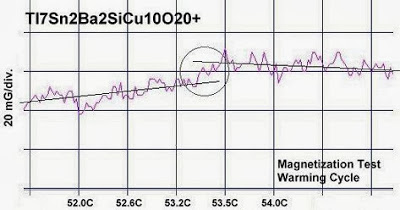

| Visitors Now: | |
| Total Visits: | |
| Total Stories: |

| Story Views | |
| Now: | |
| Last Hour: | |
| Last 24 Hours: | |
| Total: | |
Joe Eck reports Superconductor at 53.6C Almost to the hottest outdoor temperatures ever recorded
Joe Eck at Superconductors.org reports the observation of superconductivity above 53 Celsius (127F, 326K) in a new copper-oxide ceramic. The chemical formula of this discovery is Tl7Sn2Ba2SiCu10O20+. This is the thirteenth superconductor found to exhibit a Meissner transition above room temperature.
There have only been three places on Earth with recorded temperatures above 53.6C.
56.7C Death Valley
55C Kebili, Tunisia
54C Tirat Zvi, Israel
53.6C Sulaibya, Kuwait
The plots show an example of the diamagnetic transitions observed consistently above 53C. The diamagnetic shift of the transitions is on the order of 8 to 10 milli-Gauss. The low signal-to-noise ratio is due to a low volume fraction of superconductive material and a high thermal noise level inherent to these temperatures. The straight lines illustrate the average of the noise component, skewing apart at Tc.
Tl7Sn2Ba2SiCu10O20+ was created by adding additional heavy metal and CuO layers to the “c” axis of the 42 C superconductor discovered in September 2013. These extra layers change the structure from a D212 to an H212 (where H=17).
While the 48C superconductor found in October 2013 was at the maximum unit cell size of 33 Å, it did not have the maximum planar weight ratio (PWR) possible. By replacing two Ba-CuO layers in the “c” axis with two Sn-CuO layers, it was possible to add another Tl-CuO layer and increase the PWR to over 13:1. This is because tin has an ionic radius half that of barium. Furthermore, the 25% hole-doped state of the insulating layers only drops to 22% with 7 thallium atoms and 2 tins, keeping it near optimum.
Despite the low volume fraction of superconductive material, a specific heat change was clearly visible in many of the plots. A change in specific heat is one of the hallmarks of superconductivity. In both plots at page top there is a reduced warming rate between the 10-second interval below Tc versus the 10-second interval during the critical transition. In the top left plot, the temperature warms 0.6C below Tc, but only 0.3C during transition. And in the top right plot, the temperature warms 0.5C in the interval below Tc, but only 0.3C at transition.
Out of ten unambiguous tests, the lowest transition temperature observed was 53.2C and the highest was 54.3C. The average of all ten tests was 53.6C. Below are the two plots with the lowest and highest Tc transitions. Both are around 10 to 12 milli-Gauss in amplitude.
Source: http://nextbigfuture.com/2013/12/joe-eck-reports-superconductor-at-536c.html



